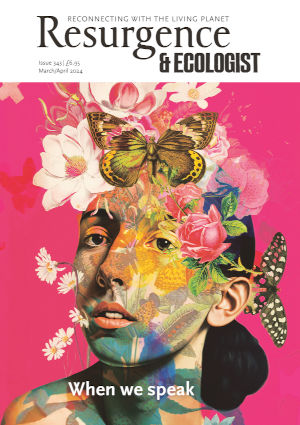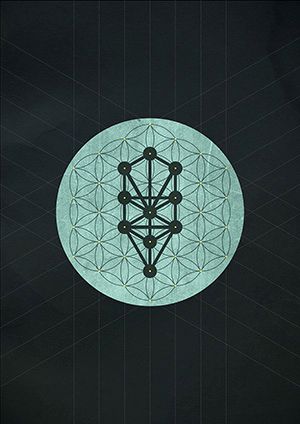Kabbalah is an ancient, mystical tradition with its roots in Judaism. Its teachings have influenced many parts of the world and many religions, philosophies and other esoteric lineages. Although we can see that most of these lineages have traditionally been led by male rabbinic individuals such as Moses Cordovero, Isaac Luria, Ibn Gabriol, Maimonides, the Baal Shem Tov, and many more, the metaphysical teachings are universal and contain the principles of masculine and feminine in perfect balance.
In the Tree of Life, the key diagram of Kabbalah, we see many different geometrical shapes. Even if you are not familiar with this drawing, you can see three pillars or columns: one in the middle, one on the right and one on the left. The circles in this diagram are ten in total and they are all directly or indirectly connected to each other. The topmost circle is called Kether and means ‘crown’, which represents unity and the one thing that exists before anything is created and where all will return eventually. The right and left circles on either side of Kether are called Chocmah and Binah. There are many ways to describe these two emanations (outpourings) or Sefirot (divine utterances). Chocmah is the masculine energy coming from Kether, defined as the wisdom and creative power of the divine. Chocmah comes out of the first point (oneness) as a straight line of energy, like a big bang shooting forth into the cosmos.
However, this divine potential would not manifest or become something defined and concrete if it would not be received and contained by the divine principle of Binah at the left side. Here we find the divine feminine and the great cosmic mother, in relation to the cosmic father (Chocmah). Binah is translated as ‘understanding’ at the left side pillar of structure and form.
The mother archetype has the capacity to receive the energy (seed) of the father in her womb. This should not be taken literally at this point in creation, nor should we think about the opposites in the sense of biological gender assignments as male and female. These ideas or principles of the masculine and feminine energies are universal and present within all created beings and creatures. In every woman and man, we find the archetypal ideas of the masculine and feminine: the giving and receiving principles.
Let us elaborate on this divine feminine idea within Kabbalah. Binah is sometimes coloured black to show that she (the mother) is all-absorbing, containing and silent. Here the masculine energy is defined and brought into form and structure. In other words, the feminine-motherly is the principle of birth, and wisdom contained in understanding. The mother (feminine) makes it possible for the father (masculine) to be born. Of course, the womb of the mother would be meaningless without the cosmic seed (potential) of the masculine. While Chocmah is the power of the creative movement, coming into existence through thunder and noise, Binah is the power of creative structure and stillness. The Kabbalist may withdraw into themself (meditation) and find the properties of stillness and listening (meditation), which are the qualities of Binah.
It is sometimes said that the seed of wisdom (Chocmah) is born in darkness and silence. This is a direct reference to the divine feminine. All the gods and goddesses are born out of the womb of Binah. In the biblical scriptures these gods and goddesses are called Elohim (plural). And it is said that they created the universe. Kabbalah makes it very clear that these two principles of the masculine and feminine are needed for anything to be created.
Although the divine feminine brings life through the birth of her womb, she also brings death. This is the universal, metaphysical principle behind the feminine in creation. Because time and space are born from her, and through her all things, beings and creatures come into existence, they are also mortal as soon as they are born. This is the great joy and sorrow that comes out of the womb of creation: the joy of birth and the sorrow of death.
Duality is born out of the great primordial mother or Binah. Everything in between birth and death happens within the womb of the mother (cosmos). All of creation are her children, coming out of her womb and returning there when the wheel of fate and destiny has turned again and another incarnation ends. The power of Saturn-Kronos is therefore appropriate to Binah, and although these are often male gods in form, they represent the feminine principle of time-space, harvest, consequence, responsibility and the deeper questions about life, our fate and destiny.
Another very important reference to the divine feminine within Kabbalah is the spiritual idea that God (transcendent), which is beyond opposites and the feminine and masculine, is also within the manifested universe. This presence or immanence is called the Shekinah and is the eternal presence of the transcendent within space and time. In other traditions this principle is called Atman, divine spark, Christ-consciousness or Buddhahood, to name a few. The Shekinah is the ever-present and eternal consciousness within existence, often described as the bride. The soul of every human being is the bridegroom of the active (masculine) principle that goes seeking for the ultimate love within the world. Tradition tells us that ‘She’ is lost or in exile and that ‘She’ must be found so that the world can be healed again. As long as the seeker or bridegroom is without the eternal beloved, there is no wholeness.
The Shekinah is traditionally remembered and preferably experienced during the Sabbath – also the seventh day of creation, which is known as the day of rest, where the soul meets the divine on Earth.
These are more ideas about the divine feminine in my new book Paths on the Tree of Wisdom, published by Watkins, and I will be exploring this topic further in my Kabbalah seminar at Hawkwood College in Stroud during a course that runs from 26 to 28 April 2024.
You can learn more about the wisdom traditions Mike Bais has integrated into his teachings and his Hawkwood College course here: www.circleofavalon.nl, www.kabbalahmysticalschool.com, tinyurl.com/hawkwood-kabbalah-2024








